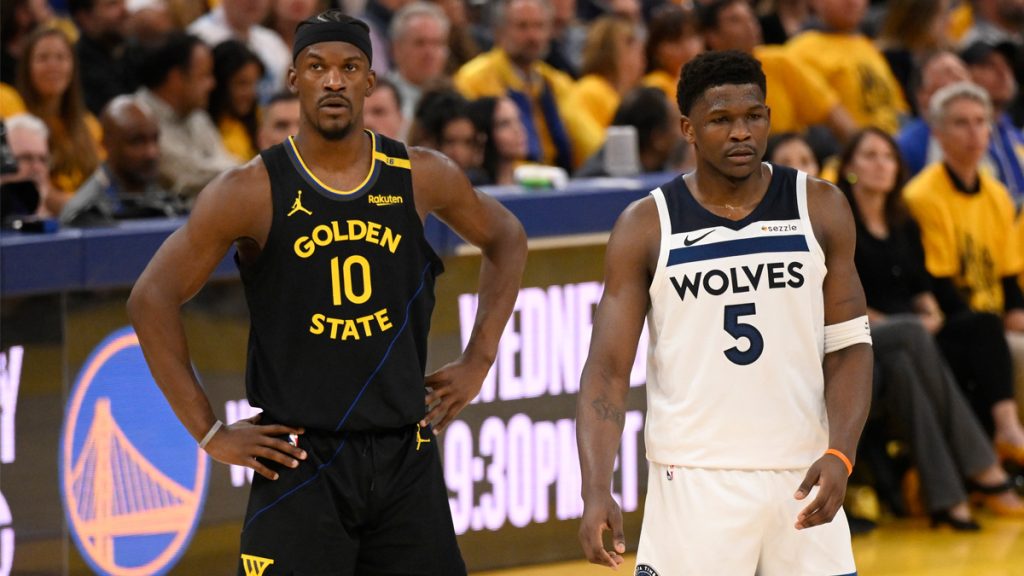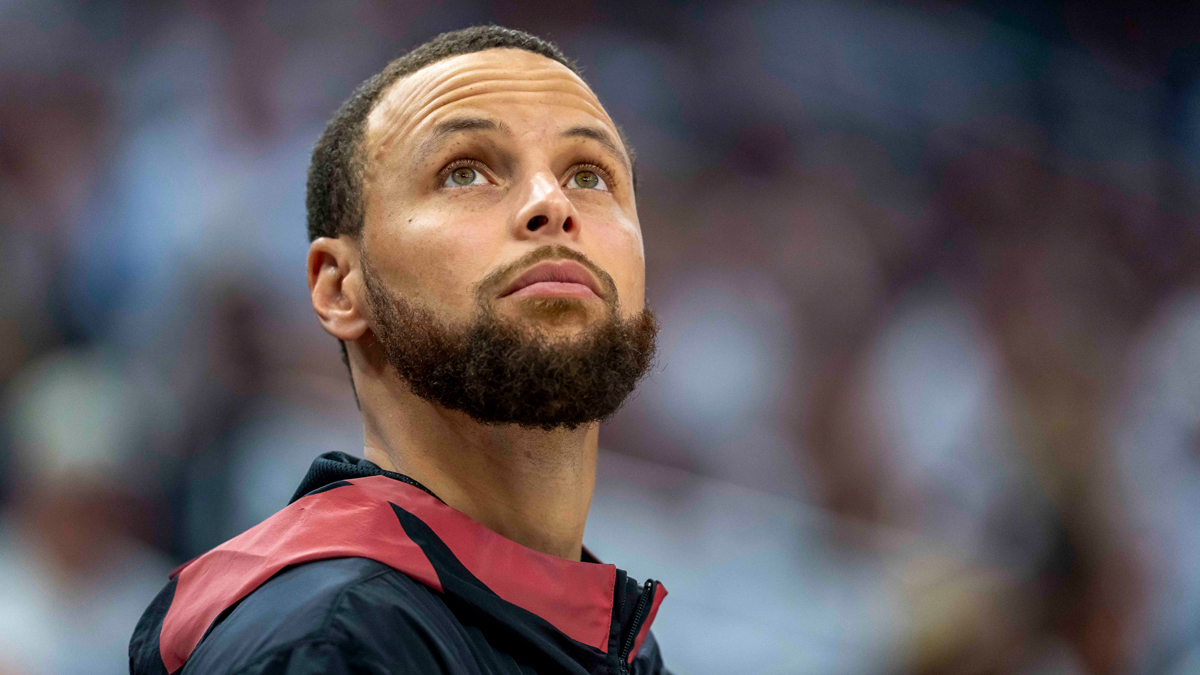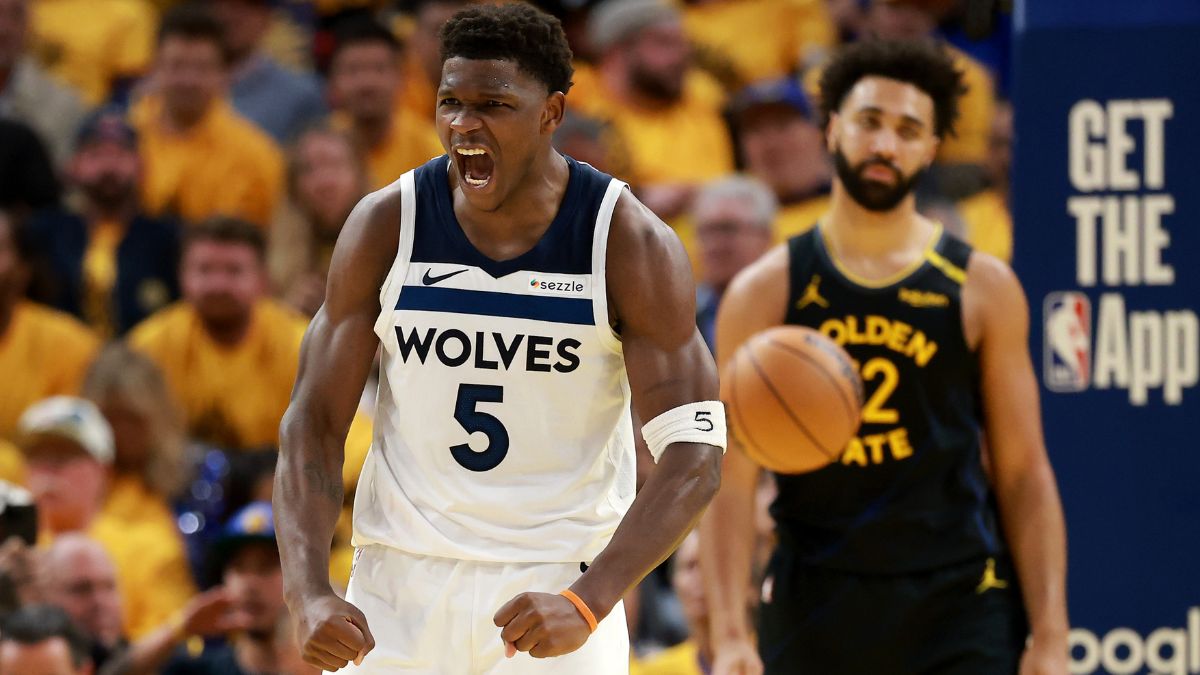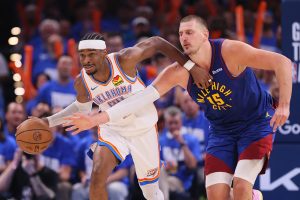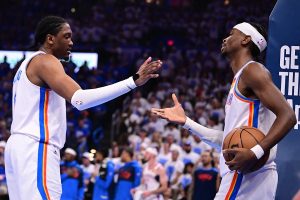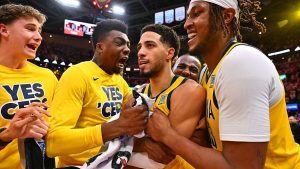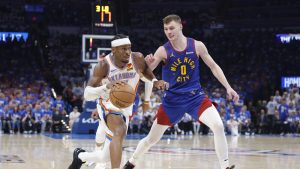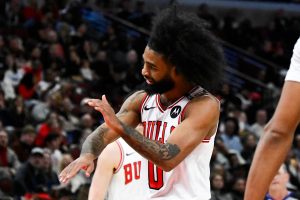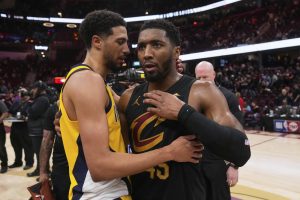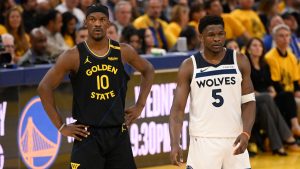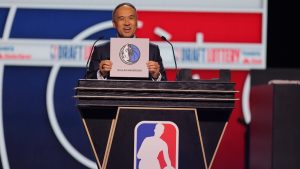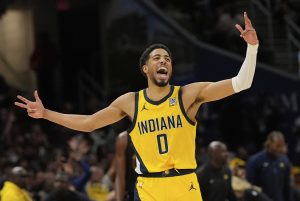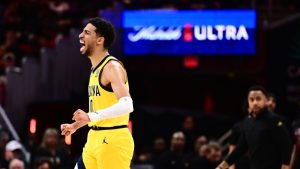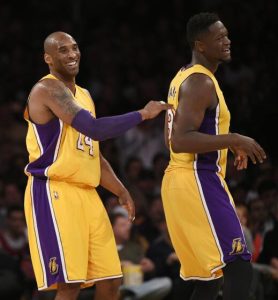Warriors must avoid another catastrophic quarter to survive Game 5 originally appeared on NBC Sports Bay Area
Erasing the white board and starting from scratch, the Warriors’ Game 2 loss against the Minnesota Timberwolves in the Western Conference semifinals was a wash.
Steve Kerr tried, quite literally, everybody. When the final buzzer rang, the Warriors lost by 24 points. The feeling of the game didn’t resemble the score. Kerr’s objective of experimental minutes was finding something that could work with Steph Curry out to a strained left hamstring.
Emerging from the rubble in that loss were Jonathan Kuminga and Trayce Jackson-Davis. Kuminga has been a go-to scorer without Curry, and Jackson-Davis has regained his old title of starting center. The last two losses are where frustration and disappointment has to kick in.
Games aren’t decided by one quarter. Throughout the playoffs, major leads have been lost in a flash. That’s the modern NBA. And yet, if it weren’t for two terrible quarters, one in each of the past two games, this series could be looking a lot different than the Warriors staring at a three-games-to-one deficit, still waiting for Curry, who officially has been ruled out for Game 5 on Wednesday.
In the Warriors’ 102-97 Game 3 loss, it was the fourth quarter that spelled doom for them. They held a four-point lead, 73-69, entering the final 12 minutes and wound up losing by five.
“It felt like a couple of offensive rebounds for them turned into threes,” Kerr said after that Game 3 loss. “I think [Anthony] Edwards had one out of the corner. [Naz] Reid, there’s a big sequence where Jimmy [Butler] had a shot at the rim. Looked like he was going to convert it, looked like he might have gotten fouled and then they went the other way and got an offensive board and Reid hit the three from the corner.
“I thought that was the sequence that really shifted the game and the momentum.”
With 10 minutes left and the Warriors ahead 75-69, Butler stepped up to set a screen for Draymond Green and rolled behind Julius Randle. Butler caught Green’s high pass, came down for his signature two-footed jump stop and rose for an attempt at the rim. Randle’s left hand was on Butler’s hip the whole time, but no foul was called and the Timberwolves gained possession.
Edwards then hit a step-back three to make it a three-point game. Kuminga countered with a layup, but on the Timberwolves’ next offensive possession, Edwards’ missed three bounced off Jaden McDaniels’ hand, Butler’s hand and into the hands of Mike Conley, who found Reid in the right corner for three points.
From that point on, the Timberwolves outscored the Warriors 27-20 the rest of the game. Butler scored 28 points through three quarters, and then went 1 of 7 for five points in the fourth.
In the Warriors’ 117-110 Game 4 loss, it was the third quarter that was disastrous.
The Warriors at halftime led by two points. While the Timberwolves had doubled the Warriors’ output from 3-point range, 10 to five, the Warriors had more rebounds (25-15), points in the paint (26-16), fastbreak points (9-8) and second-chance points (10-2). Their two-point lead then was wiped away to a 20-point Timberwolves lead going into the fourth quarter.
They went from having just six turnovers in the first half to seven in the third quarter alone. It’s their defense, Kerr believes, that preceded bigger problems.
“Defensive connection,” Kerr said Tuesday in a Zoom with media members, one day after the Warriors’ Game 4 loss. “We had done a really good job the previous couple games of just staying connected. I thought our offensive woes in the middle of the third quarter led to some of the transition stuff. They hit some tough shots, but it didn’t feel like we ever had control of them in the third.
“We have to stay better connected and make sure we’re forcing tougher shots than what we gave up in that fourth quarter.”
The Warriors went 7 of 19 from the field in the third quarter of Game 4, and missed all six of their 3-point attempts. The Timberwolves had more rebounds (10-5), points in the paint (18-12), fastbreak points (11-2) and second-chance points (7-2), while shooting 15 of 23 overall and 6 of 12 on threes.
There’s a theme between both quarters: Edwards scored 13 points in the fourth quarter of Game 3, and 16 in the third quarter of Game 4.
Through the last two games, the Warriors have tied or won six of eight quarters. The only two that they lost were the fourth quarter of Game 3 and the third quarter of Game 4, when the Timberwolves outscored them by a combined 31 points. In the other six quarters, the Warriors have outscored the Timberwolves by 19 points the last two games.
To keep the season alive and the hopes of getting Curry back with three days in between Game 6, the Warriors simply have to avoid a catastrophic quarter in Game 5.
Download and follow the Dubs Talk Podcast
Warriors must avoid another catastrophic quarter to survive Game 5
Erasing the white board and starting from scratch, the Warriors’ Game 2 loss against the Minnesota Timberwolves in the Western Conference semifinals was a wash.
Steve Kerr tried, quite literally, everybody. When the final buzzer rang, the Warriors lost by 24 points. The feeling of the game didn’t resemble the score. Kerr’s objective of experimental minutes was finding something that could work with Steph Curry out to a strained left hamstring.
Emerging from the rubble in that loss were Jonathan Kuminga and Trayce Jackson-Davis. Kuminga has been a go-to scorer without Curry, and Jackson-Davis has regained his old title of starting center. The last two losses are where frustration and disappointment has to kick in.
Games aren’t decided by one quarter. Throughout the playoffs, major leads have been lost in a flash. That’s the modern NBA. And yet, if it weren’t for two terrible quarters, one in each of the past two games, this series could be looking a lot different than the Warriors staring at a three-games-to-one deficit, still waiting for Curry, who officially has been ruled out for Game 5 on Wednesday.
In the Warriors’ 102-97 Game 3 loss, it was the fourth quarter that spelled doom for them. They held a four-point lead, 73-69, entering the final 12 minutes and wound up losing by five.
“It felt like a couple of offensive rebounds for them turned into threes,” Kerr said after that Game 3 loss. “I think [Anthony] Edwards had one out of the corner. [Naz] Reid, there’s a big sequence where Jimmy [Butler] had a shot at the rim. Looked like he was going to convert it, looked like he might have gotten fouled and then they went the other way and got an offensive board and Reid hit the three from the corner.
“I thought that was the sequence that really shifted the game and the momentum.”
Golden State Warriors
Find the latest Golden State Warriors news, highlights, analysis and more with NBC Sports Bay Area and California.
With 10 minutes left and the Warriors ahead 75-69, Butler stepped up to set a screen for Draymond Green and rolled behind Julius Randle. Butler caught Green’s high pass, came down for his signature two-footed jump stop and rose for an attempt at the rim. Randle’s left hand was on Butler’s hip the whole time, but no foul was called and the Timberwolves gained possession.
Edwards then hit a step-back three to make it a three-point game. Kuminga countered with a layup, but on the Timberwolves’ next offensive possession, Edwards’ missed three bounced off Jaden McDaniels’ hand, Butler’s hand and into the hands of Mike Conley, who found Reid in the right corner for three points.
From that point on, the Timberwolves outscored the Warriors 27-20 the rest of the game. Butler scored 28 points through three quarters, and then went 1 of 7 for five points in the fourth.
In the Warriors’ 117-110 Game 4 loss, it was the third quarter that was disastrous.
The Warriors at halftime led by two points. While the Timberwolves had doubled the Warriors’ output from 3-point range, 10 to five, the Warriors had more rebounds (25-15), points in the paint (26-16), fastbreak points (9-8) and second-chance points (10-2). Their two-point lead then was wiped away to a 20-point Timberwolves lead going into the fourth quarter.
They went from having just six turnovers in the first half to seven in the third quarter alone. It’s their defense, Kerr believes, that preceded bigger problems.
“Defensive connection,” Kerr said Tuesday in a Zoom with media members, one day after the Warriors’ Game 4 loss. “We had done a really good job the previous couple games of just staying connected. I thought our offensive woes in the middle of the third quarter led to some of the transition stuff. They hit some tough shots, but it didn’t feel like we ever had control of them in the third.
“We have to stay better connected and make sure we’re forcing tougher shots than what we gave up in that fourth quarter.”
The Warriors went 7 of 19 from the field in the third quarter of Game 4, and missed all six of their 3-point attempts. The Timberwolves had more rebounds (10-5), points in the paint (18-12), fastbreak points (11-2) and second-chance points (7-2), while shooting 15 of 23 overall and 6 of 12 on threes.
There’s a theme between both quarters: Edwards scored 13 points in the fourth quarter of Game 3, and 16 in the third quarter of Game 4.
Through the last two games, the Warriors have tied or won six of eight quarters. The only two that they lost were the fourth quarter of Game 3 and the third quarter of Game 4, when the Timberwolves outscored them by a combined 31 points. In the other six quarters, the Warriors have outscored the Timberwolves by 19 points the last two games.
To keep the season alive and the hopes of getting Curry back with three days in between Game 6, the Warriors simply have to avoid a catastrophic quarter in Game 5.
Download and follow the Dubs Talk Podcast
This article tagged under:
Jimmy ButlerSteve KerrJonathan KumingaTrayce Jackson-DavisAnthony Edwards

